[author: Blair Slattery]
Introduction
This article focuses on the income approach to determining the marital standard of living (MSOL), with particular emphasis on Marriage of Cheriton (2001) 92 Cal.App.4th 269 and Marriage of Ackerman (2006) 146 Cal.App.4th 191.
As a preface for this article, I want to highlight some language pertaining to MSOL from California family law cases and the Family Code as follows:
-
FC, § 4330, subd. (a) – “In a judgment of dissolution of marriage or legal separation of the parties, the court may order a party to pay for the support of the other party an amount, for a period of time, that the court determines is just and reasonable, based on the standard of living established during the marriage… ”[emphasis added here and hereafter]
-
Marriage of Nelson (2006) 139 Cal.App.4th 1546 – “Section 4330 does not make ‘marital standard of living’ the absolute measure of reasonable need. ‘Marital standard of living’ is merely a threshold or reference point against which all of the statutory factors may be weighed. It is neither a floor nor a ceiling for a spousal support award. The Legislature intended ‘marital standard of living’ to be a general description of the station in life that the parties had achieved by the date of separation.”
-
FC, § 4320, subd. (a) – “The extent to which the earning capacity of each party is sufficient to maintain the standard of living established during the marriage.”
-
FC, § 4320, subd. (c) – “The ability of the support- ing party to pay spousal support, taking into account the supporting party’s earning capacity, earned and unearned income, assets, and standard of living.”
-
FC, § 4320, subd. (d) – “The needs of each party based on the standard of living established during the marriage.”
Family Code section 4320, subdivisions (a) and (c) are of particular interest to me for this article because they discuss the MSOL vis-à-vis the supporting party and not only the supported party (out-spouse). In my experience the MSOL is often associated with only the out-spouse. This is important to keep in mind as it is often impossible for both parties to maintain their standard of living after the date of separation, primarily due to the inability for both spouses to continue to live in the same size residence as when they were married. However, in rare circumstances when there is substantial income, both parties can maintain a residence as they enjoyed during the marriage.
Determining MSOL
As a family law forensic accountant, I think of two main methods of determining the MSOL:
-
The expense method
-
The income approach
The expense method attempts to capture the actual expenses for a party and/or all or part of the expenses for the children. The income approach also attempts to allocate expenses to parties and/or children, but the income approach looks primarily at the sources of income to determine reasonable consumption. The expense method does not consider the income, it relies on actual or estimated expenses of one or both parties.
Marriage of Weinstein (1991) 4 Cal.App.4th 555
This was a predecessor case to Cheriton and Ackerman. The parties lived beyond their means in Weinstein, so the court looked to income as the only available measure of a reasonable standard of living. At trial, wife was seeking $14,000 per month in permanent spousal support, but the court awarded her $8,500 per month. “Appellant [wife] contends the award must be reversed because the trial court employed an erroneous definition of marital standard of living, failed to award sufficient support to satisfy the need it determined to exist…”1 “Appellant’s (Wife) main contention is that the trial court erred in defining the marital standard of living by reference to the parties’ income during marriage rather than their actual expenditures…”2 The wife did not prevail in Weinstein.
Marriage of Cheriton (2001) 92 Cal.App.4th 269
In this case, the parties lived below their means. The parties saved what they did not spend. Husband was a computer science professor at Stanford University. However, Cheriton had the unusual circumstances that there was a post-nuptial agreement by which husband received a $45 million windfall as his separate property after the sale of a side business to Cisco Systems, Inc. The Cheriton case stated a court can order support above MSOL, particularly true where parties lived below their means (savings). A mathematical formula of MSOL based on income and expenses, less husband’s share of the household consumption was affirmed. In Figure 1 (below) is a schedule representing my mathematical interpretation of the Cheriton court’s determination of MSOL and the imputed income and support components that enabled the Cheriton out-spouse wife to maintain her MSOL.
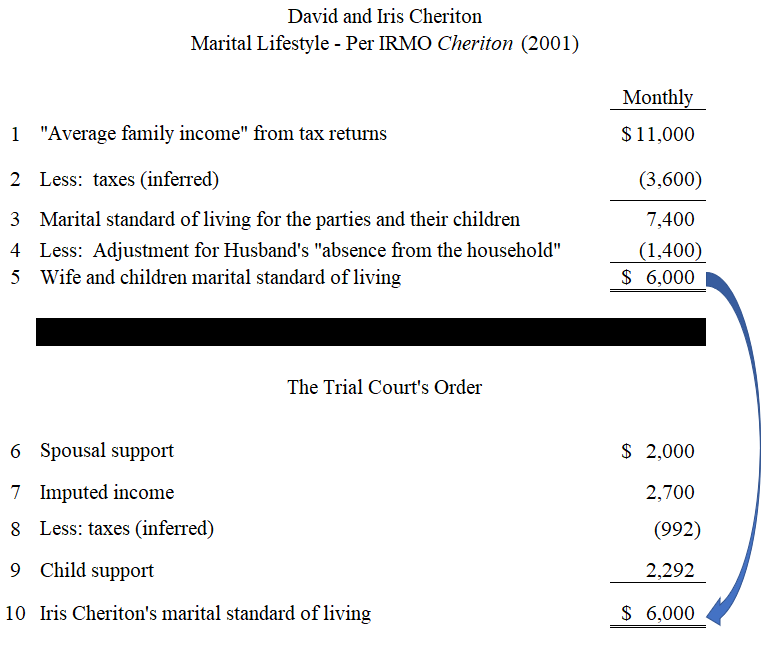
Figure 1
It is important to note that the court included 100% of the children as part of wife’s marital standard of living. If there were no children, there would theoretically be no need to make an adjustment for husband’s “absence from the household” on line four in the table above, and the determination of MSOL would be more straightforward. In the Cheriton case, the husband remained in the family residence after separation while the wife and four children were living in a cramped living space, with the four children sharing two bedrooms and the wife sleeping on a couch. Husband was able to maintain his standard of living in the family residence with the assistance of the $45 million he received as his separate property post-separation.
Marriage of Ackerman (2006) 146 Cal.App.4th 19
In this case, the parties lived beyond their means, as in the Weinstein case. Mr. Ackerman was a Newport Beach, Orange County plastic surgeon. Below, in Figure 2, is my schedule interpreting the Ackerman court’s determination of MSOL and the income and support components that enabled the Ackerman out-spouse wife to maintain her MSOL:
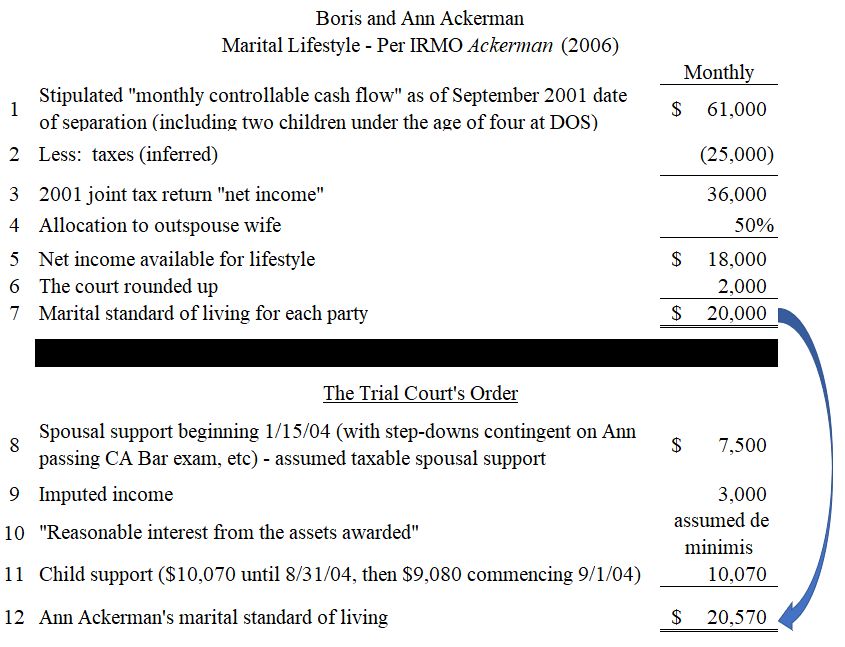
Figure 2
Ackerman differs from Cheriton in that the children’s portion of the income/consumption is allocated 50% to each party (see line 4 in the table above). As this article segues to variations that exclude children’s expenses, I pose a few questions/hypotheticals below:
-
If we hypothetically assume that the Ackerman’s children turned 18 two years after the court’s order above, does that mean that wife would be left with only $10,500 [$7,500 spousal support + $3,000 imputed income]? If there was a support modification, would a court give wife increased spousal support from funds that were previously spent on the children? If husband no longer has his child support obligation, his net spendable income would be approximately $30,000 vs. wife’s approximate $10,000. That is quite a large disparity between the parties.
-
If the Ackermans never had children and their total combined income was the same as in the Ackerman case, wife’s net spendable income would be significantly higher than the scenario above where I posit Mrs. Ackerman’s net spendable income after her child support terminates.
-
I believe it is safe to assume that if the parents were not spending/investing money on their children, the parties would have spent that money on themselves and/or saved the funds. So, can an argument be made that children’s expenses could be converted to savings as a component of wife’s MSOL once the children turn 18?
Excluding Children’s Expenses in a Cheriton or Ackerman Framework
California family law forensic accountants will often exclude children’s expenses in Cheriton/Ackerman analyses, even though such exclusions are not present in the Cheriton and Ackerman cases. I have seen three resources/methods for excluding children’s expenses which are:
-
With the income/cash flow, number of children, and all other inputs included in a DissoMaster™, make the custody percentage zero. This will result in a total child support amount that can be used to estimate children’s expenses.
-
Another tool for estimating children’s expenses is the study “Estimating Personal Consumption with and Without Savings in Wrongful Death Cases” written by Martine Ajwa, Gerald Martin, and Ted Vavoulis.3
-
Finally, the annual “Expenditures on Children by Families” by the United States Department of Agriculture is another useful resource for estimating children’s consumption of a family’s income.4
The results of the above methods of estimating and excluding children’s expenses are compared to the Cheriton and Ackerman cases in the hypothetical scenario that follows in Figure 3.
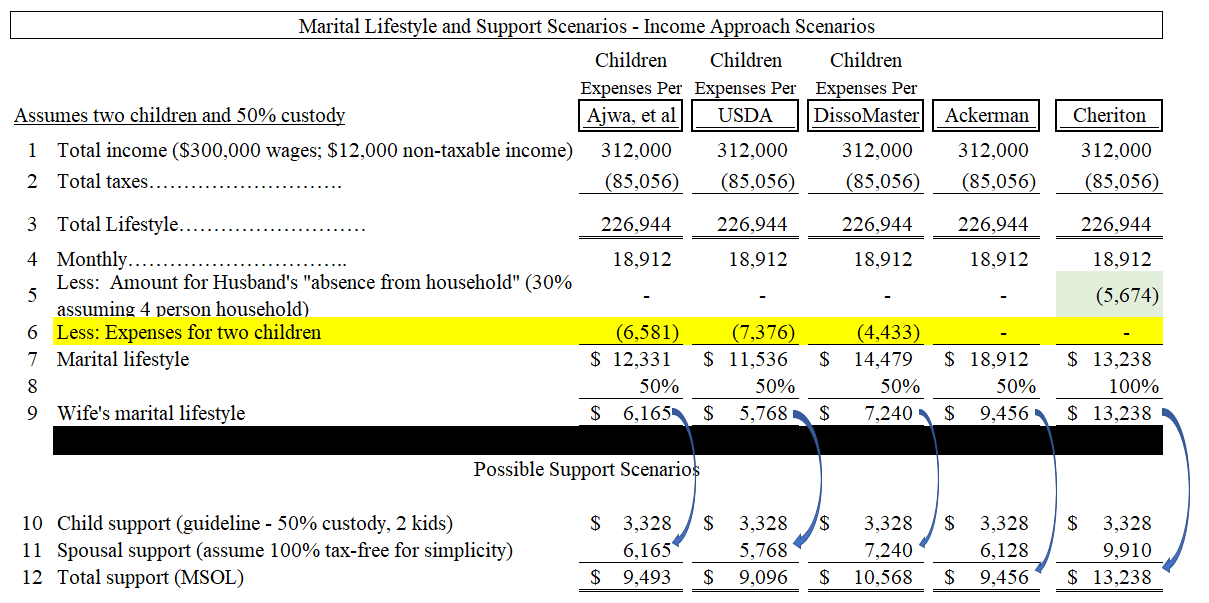
Figure 3
Adjustment for Housing Expenses
Another common variation on a Cheriton/Ackerman analysis is an adjustment for housing. Like the adjustment for children, an adjustment for housing is not explicit in the original Cheriton/Ackerman cases. The concept of the housing adjustment is to allocate the housing expenses typically to the out-spouse. Again, a housing adjustment makes less practical sense in a situation where there are not enough funds to pay for two households of similar expense, which is the case for an overwhelming majority of families. Below (Figure 4) is an example with an adjustment for housing expenses compared to a hypothetical Cheriton:

Figure 4
Isolate the Estimated Expenses for Only One Spouse
Instead of an adjustment for children, sometimes an adjustment will be made to estimate only the out-spouse’s consumption, sometimes in combination with a housing expense adjustment. In addition to estimating children’s expenses, the aforementioned “Estimating Personal Consumption with and Without Savings in Wrongful Death Cases” study can also be used to estimate the household consumption of one adult in families. Such an example is depicted in the table below, again compared to a hypothetical Cheriton:
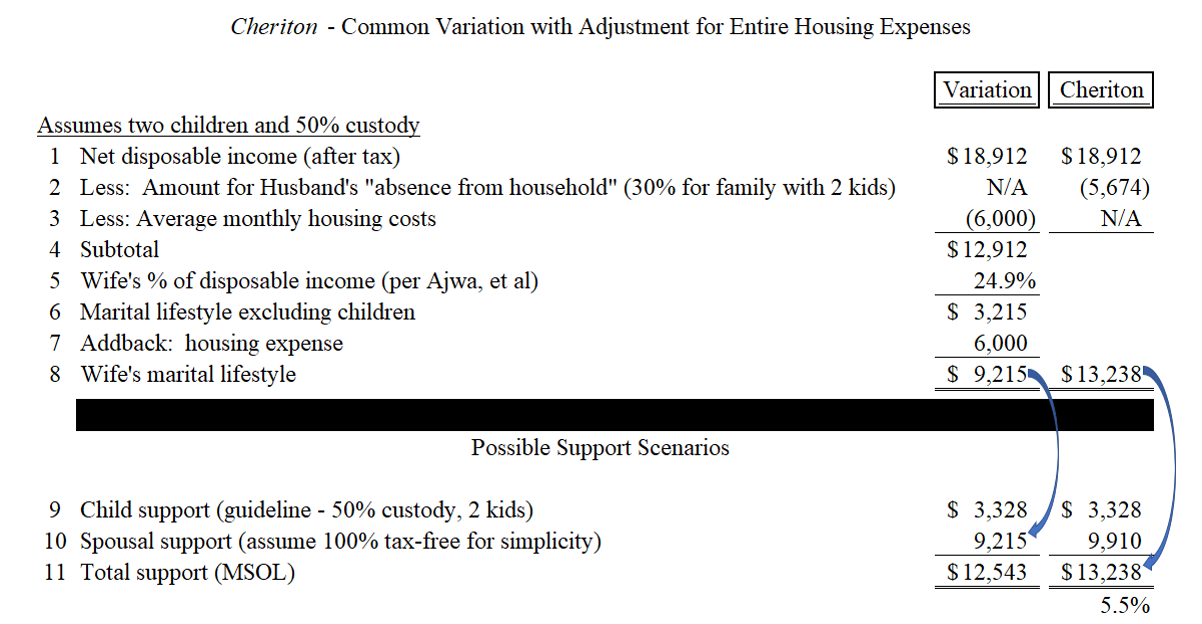
Figure 5
Adjustment for CPI Inflation
Family law attorneys and forensic accountants should consider adjusting the MSOL for the increase/decrease in inflation and/or the consumer price index (CPI). This is especially important when the date of separation is at least five years earlier than the date of trial. In the table (Figure 6) below on line 9, the MSOL can be increased by approximately 8.58% using the increase in CPI over the five years that elapsed since the date of separation. A very easy-to-use CPI inflation calculator can be found at the following website: https://www.bls.gov/data/inflation_calculator.htm.
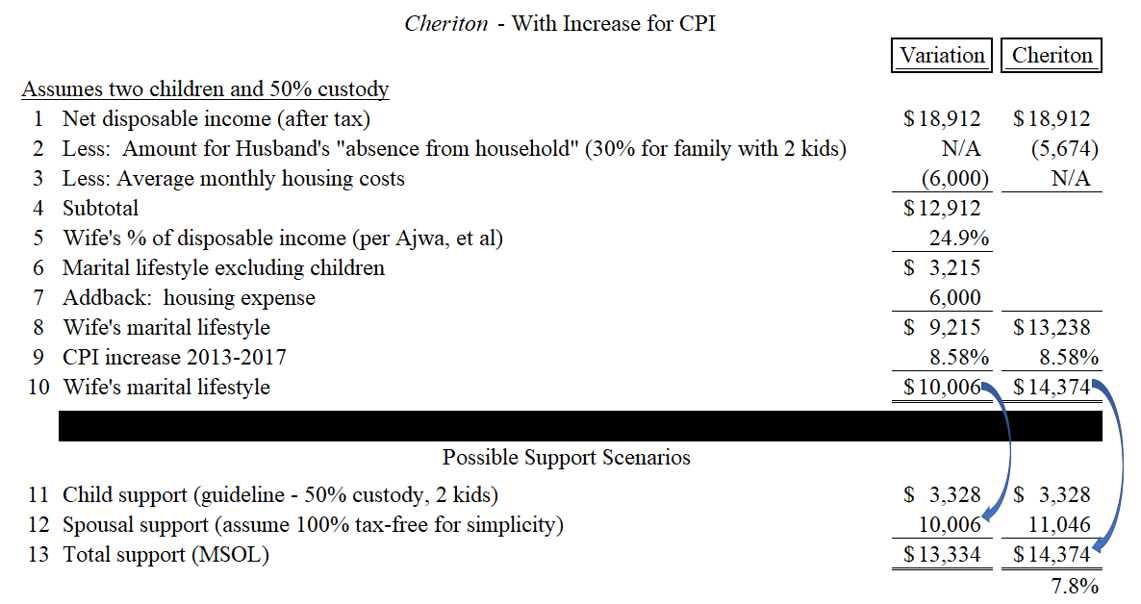
Figure 6
Conclusion
Analyses are often labeled as being faithful to the principles enunciated in Cheriton and Ackerman, but they are not. Usually, they are a variation such as discussed earlier herein. Practitioners should be aware of the intentions and methods of the Cheriton and Ackerman courts and how their orders resulted in the out-spouse’s MSOL. Practitioners should also be aware of common variations on Cheriton and Ackerman and some of the tools that are used to effectuate those variations.
References
-
Marriage of Weinstein (1991) 4 Cal.App.4th 555, 559.
-
Id. at p. 565
-
Martine Ajwa, Gerald Martin & Ted Vavoulis. Estimating Personal Consumption with and Without Savings in Wrongful Death Cases. (2000). Retrieved from: http://citeseerx.ist.psu.edu/viewdoc/download?doi= 10.1.1.1013.8376&rep=rep1&type=pdf. Note: may require subscription to access.
-
United States Department of Agriculture. Expenditures on Children by Families. Retrieved from: https://www.fns.usda.gov/resource/ expenditures-children-families-reports-all-years